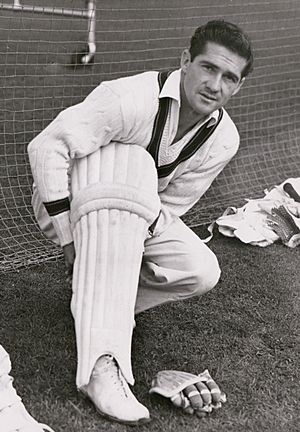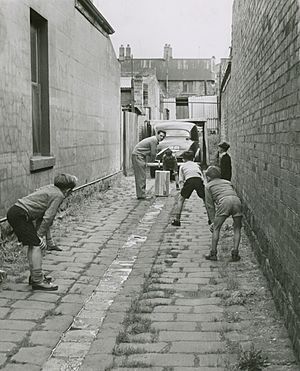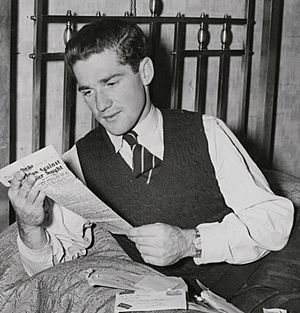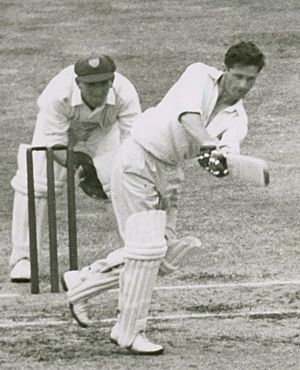Neil Harvey facts for kids

Harvey in 1950
|
||||||||||||||||||||||||||||||||||||||||
| Personal information | ||||||||||||||||||||||||||||||||||||||||
|---|---|---|---|---|---|---|---|---|---|---|---|---|---|---|---|---|---|---|---|---|---|---|---|---|---|---|---|---|---|---|---|---|---|---|---|---|---|---|---|---|
| Full name |
Robert Neil Harvey
|
|||||||||||||||||||||||||||||||||||||||
| Born | 8 October 1928 Fitzroy, Victoria, Australia |
|||||||||||||||||||||||||||||||||||||||
| Nickname | Ninna | |||||||||||||||||||||||||||||||||||||||
| Height | 1.71 m (5 ft 7 in) | |||||||||||||||||||||||||||||||||||||||
| Batting | Left-handed | |||||||||||||||||||||||||||||||||||||||
| Bowling | Right-arm off-spin | |||||||||||||||||||||||||||||||||||||||
| Role | Top-order batsman | |||||||||||||||||||||||||||||||||||||||
| Relations |
|
|||||||||||||||||||||||||||||||||||||||
| International information | ||||||||||||||||||||||||||||||||||||||||
| National side |
|
|||||||||||||||||||||||||||||||||||||||
| Test debut (cap 178) | 23 January 1948 v India | |||||||||||||||||||||||||||||||||||||||
| Last Test | 15 February 1963 v England | |||||||||||||||||||||||||||||||||||||||
| Domestic team information | ||||||||||||||||||||||||||||||||||||||||
| Years | Team | |||||||||||||||||||||||||||||||||||||||
| 1946/47–1956/57 | Victoria | |||||||||||||||||||||||||||||||||||||||
| 1958/59–1962/63 | New South Wales | |||||||||||||||||||||||||||||||||||||||
| Career statistics | ||||||||||||||||||||||||||||||||||||||||
|
||||||||||||||||||||||||||||||||||||||||
|
Source: CricketArchive, 29 February 2008
|
||||||||||||||||||||||||||||||||||||||||
Robert Neil Harvey (born 8 October 1928) is a famous Australian former cricketer. He played for the Australian cricket team from 1948 to 1963. He was the team's vice-captain from 1957 until he retired.
Neil Harvey was a left-handed batsman who liked to attack the ball. He was also a great fielder and sometimes bowled off-spin. Many people thought he was the best fielder of his time. When he retired, he had scored the second-most runs and centuries for Australia in Test cricket.
He was one of six brothers who played cricket, and four of them played for Victoria. Neil Harvey joined the Test team in January 1948, when he was just 19 years old. In his second match, he became the youngest Australian to score a Test century, a record that still stands today.
Harvey was the youngest player in the famous 1948 "Invincibles" team led by Don Bradman. This team toured England and is known as one of the best cricket teams ever. Neil Harvey started his career very strongly, scoring six centuries in his first thirteen Test innings. He was named one of the Wisden Cricketers of the Year in 1954. This was because he scored over 2,000 runs during the 1953 tour of England.
Contents
Early Life & Cricket Beginnings
Neil Harvey was the fifth of six boys born to Horace Harvey. The family moved to Melbourne in 1926, settling in Fitzroy. All six boys learned to play cricket from their father. They played with a tennis ball on cobblestones or a marble in the backyard.
Neil started playing cricket at age nine as a wicket-keeper for his school team. He once scored 112 runs in a school final. At twelve, he joined the local Fitzroy club. By age fourteen, he was playing for the first-grade team. He later stopped wicket-keeping to focus on his batting.
First-class cricket, which is a high level of cricket, started again in 1945–46 after World War II. Neil Harvey was selected for the Victorian team at 18. In his second first-class match, he scored his first century, making 154 runs. He said his elder brother Merv, who also played Test cricket, inspired him.
Harvey made his debut in the Sheffield Shield competition against New South Wales. He scored 49 runs in the second innings, helping Victoria win the title. Later, he played against Wally Hammond's English team. He scored 69 runs, and his opponents knew he would become a Test player.
Test Debut & "The Invincibles"
In 1947–48, Neil Harvey played in two Shield matches with his brothers Merv and Ray. He scored 87 against the touring Indian cricket team. He was then chosen for an Australian XI team that played India before the Tests.
Three months after his 19th birthday, Harvey played his first international match. This was in the Fourth Test against India in January 1948. He scored 13 runs in his only innings. The selectors kept him for the Fifth Test in Melbourne. On 7 February 1948, he scored 153 runs. This made him the youngest Australian to score a Test century, a record he still holds.
This great innings helped him earn a spot on the 1948 tour of England. This team was known as "The Invincibles." At first, Harvey found it hard to play in English conditions. He struggled in his first few innings.
However, he improved his game. He scored 100 not out against Sussex before the first Test. He was still the 12th man for the first two Tests. But when opener Sid Barnes got injured, Harvey got his chance in the Fourth Test.
A Century on Ashes Debut
Harvey played his first Ashes Test at Headingley. England had scored 496 runs. Australia was struggling at 3 wickets for 68 runs. Harvey, the youngest player, joined Keith Miller. They launched a strong counterattack. Miller hit many boundaries, and Harvey joined in.
Harvey reached his century in 177 minutes, hitting 14 fours. He scored 112 runs from 183 balls. He was the first Australian left-hander to score a century on his Ashes debut. His innings helped Australia score 458 runs. In the second innings, Harvey took two amazing catches. Australia then chased down a world record 404 runs to win the match.
He finished the tour with 1129 runs at an average of 53.76. He was also known as an amazing fielder. Many said he was the best fielder in the Australian team.
Becoming a Key Batsman
After Don Bradman retired, Neil Harvey had to take on more responsibility. He became a key batsman for Australia. In the 1949–50 tour of South Africa, he set several Australian records. He scored 660 runs at an average of 132.00 in the Tests. This was the most runs by a visiting batsman in South Africa.
He scored 178 runs in the Second Test and an unbeaten 151 runs in the Third Test. This 151 not out was one of his best innings. He scored it on a difficult, crumbling pitch. He guided Australia to an unlikely victory. He scored four centuries in a row in the series. He finished the series with 116 runs in the Fifth Test, as Australia won 4–0.
In the 1950–51 Ashes series in Australia, Harvey scored 362 runs at 40.22. He had three half-centuries. He helped Australia win the series 4–1.
The 1951–52 season was less successful for him. He scored 261 runs at 26.10 against the West Indian cricket team. He found it hard to play against the spin bowlers Alf Valentine and Sonny Ramadhin.
Peak Performance Years
The 1952–53 season saw Neil Harvey at his best. He scored 109 and 52 in the First Test against South Africa. He then scored 190 in the Third Test in Sydney. This helped Australia win by an innings. He made it three centuries in a row with 116 in Adelaide.
He scored his highest Test score of 205 in the Fifth Test in Melbourne. Australia won the series 4–0. Harvey scored 834 runs at 92.66 in the series. This was a record for a series against South Africa. In total, he scored 1,659 runs at 63.81 for the season. This was the second-highest tally in Australian history.

In 1953, he toured England again. He became only the third Australian in 25 years to score 2,000 runs on an Ashes tour. He scored 2,040 runs at 65.80. He made ten centuries, twice as many as any other player.
In the Tests, he scored 346 runs at 34.60. He was the second-highest run-scorer for Australia. He was named one of the Wisden Cricketers of the Year for his great performances.
The 1954–55 season saw England tour Australia. Harvey scored 162 in the First Test in Brisbane. This helped Australia win by an innings. In the Second Test in Sydney, he played one of his greatest innings. He scored an unbeaten 92 runs on a very difficult pitch. No other batsman scored more than 15 runs in that innings. England won the match, but Harvey's innings was legendary.
He then toured the West Indies in 1955. He started with two centuries, scoring 133 in the First and Second Tests. He also scored his second double century, 204, in the Fifth Test. He finished the series with 650 runs at 108.33.
Challenges and Leadership
The 1956 Ashes tour to England was tough for Neil Harvey and the Australian team. The English spin bowlers, Jim Laker and Tony Lock, were very successful. Harvey struggled, scoring only 197 runs at 19.70 in five Tests. In one match, Laker took a world record 19 wickets, and Australia lost badly.
After the tour, Australia played Tests in Pakistan and India. Harvey scored 96 on a difficult pitch in the First Test in Dhaka. He was ill during the innings but still played brilliantly. He then scored 140 in the Second Test in Mumbai. He finished the India series with 253 runs at 63.25.
In 1957, the Australian team leaders retired. Neil Harvey was the most experienced player. Many expected him to become captain. However, the captaincy went to Ian Craig, who was only 22 years old. Harvey was named vice-captain.
Harvey was upset by this decision. He showed his skill by scoring 209 runs for Victoria against New South Wales. This was his first double century for Victoria. He finished the season with an average of 104.50.
In 1958, Harvey moved to New South Wales for a job. This meant he gave up the Victorian captaincy. When Ian Craig became ill, Richie Benaud was made Australian captain instead of Harvey. Harvey continued as vice-captain.
Vice-Captain and Final Years
As vice-captain to Richie Benaud, Neil Harvey helped Australia win the Ashes 4–0 in 1958–59. His best innings was a brilliant 167 in the Second Test in Melbourne. This helped Australia win the match.
In 1959–60, Australia toured Pakistan and India. Harvey scored 96 on a very difficult matting pitch in Dhaka. This innings was called "one of his most dazzling." He also scored 114 in the First Test in Delhi and 102 in the Third Test in Mumbai. Australia won both series.
In his last years, Harvey's Test scores were not as high. However, he still had some great moments. In 1961, he captained Australia for the only time in a Test match. This was at Lord's against England. Benaud was injured, so Harvey led the team in a famous match known as "The Battle of the Ridge." Australia won by five wickets. Harvey said it was "probably my proudest moment."
He scored 114 in the First Test of that series. He also made 73 and 53 in the Third Test. Australia won the series 2–1.
Neil Harvey retired at the end of the 1962–63 season. He scored his 21st and final Test century, 154, in the Fourth Test in Adelaide. In his last Test match in Sydney, he took six catches, equaling a world record. He retired as Australia's most capped player at the time. Only Don Bradman had scored more runs and centuries for Australia.
Playing Style & Legacy
Neil Harvey was known for his artistic and aggressive batting style. He was a short man but had great timing. He was especially good against spin bowling, often charging down the pitch to hit the ball. Even though he ran out of his crease a lot, he was never stumped in a Test match.
He believed that any ball could be hit for runs. After Donald Bradman retired, Harvey was seen as Australia's leading batsman. He was the first Australian to score Test centuries in 15 different cities. He also scored 67 first-class centuries across 35 venues in six countries.
Harvey started as a wicket-keeper but became an amazing fielder. He was known as one of the best fielders in the world. He played baseball in winter, which helped his fielding skills. His throws were very fast and accurate.
After retiring from playing, Harvey became an Australian selector from 1967 to 1979. He was chairman of selectors from 1971 onwards. He was inducted into the Australian Cricket Hall of Fame in 2000. In 2009, he was one of the first 55 players inducted into the ICC Cricket Hall of Fame. He also received the Medal of the Order of Australia in 2018 for his service to cricket.
As of February 2025, Neil Harvey became the oldest living Test cricketer.
Test Match Performance
| Batting | Bowling | ||||||||
|---|---|---|---|---|---|---|---|---|---|
| Opposition | Matches | Runs | Average | High score | 100s/50s | Wickets | Average | Best bowling (innings) | |
| England | 37 | 2,416 | 38.34 | 167 | 6/12 | 0 | – | – | |
| India | 10 | 775 | 59.63 | 153 | 4/2 | 2 | 29.50 | 1/8 | |
| Pakistan | 4 | 279 | 39.85 | 96 | 0/2 | 0 | – | – | |
| South Africa | 14 | 1,625 | 81.25 | 205 | 8/5 | 1 | 20.00 | 1/9 | |
| West Indies | 14 | 1,054 | 43.91 | 204 | 3/3 | 0 | – | – | |
| Overall | 79 | 6,149 | 48.21 | 205 | 21/24 | 3 | 40.00 | 1/8 | |
Test Centuries
This table shows the centuries Neil Harvey scored in Test matches.
- In the column Runs, * means he was not out.
- The column Match is the Test match number in Harvey's career.
| Runs | Match | Opponent | City | Venue | Year | Result |
|---|---|---|---|---|---|---|
| 153 | 2 | Melbourne, Australia | Melbourne Cricket Ground | 1948 | Won | |
| 112 | 3 | Leeds, England | Headingley | 1948 | Won | |
| 178 | 6 | Cape Town, South Africa | Newlands | 1949 | Won | |
| 151* | 7 | Durban, South Africa | Kingsmead | 1950 | Won | |
| 100 | 8 | Johannesburg, South Africa | Ellis Park | 1950 | Drawn | |
| 116 | 9 | Port Elizabeth, South Africa | St George's Park | 1950 | Won | |
| 109 | 20 | Brisbane, Australia | Brisbane Cricket Ground | 1952 | Won | |
| 190 | 22 | Sydney, Australia | Sydney Cricket Ground | 1953 | Won | |
| 116 | 23 | Adelaide, Australia | Adelaide Oval | 1953 | Drawn | |
| 205 | 24 | Melbourne, Australia | Melbourne Cricket Ground | 1953 | Lost | |
| 122 | 27 | Manchester, England | Old Trafford Cricket Ground | 1953 | Drawn | |
| 162 | 30 | Brisbane, Australia | Brisbane Cricket Ground | 1954 | Won | |
| 133 | 35 | Kingston, Jamaica | Sabina Park | 1955 | Won | |
| 133 | 36 | Port of Spain, Trinidad | Queen's Park Oval | 1955 | Drawn | |
| 204 | 39 | Kingston, Jamaica | Sabina Park | 1955 | Won | |
| 140 | 47 | Mumbai, India | Brabourne Stadium | 1956 | Drawn | |
| 167 | 54 | Melbourne, Australia | Melbourne Cricket Ground | 1958 | Won | |
| 114 | 61 | Delhi, India | Feroz Shah Kotla | 1959 | Won | |
| 102 | 63 | Bombay, India | Brabourne Stadium | 1960 | Drawn | |
| 114 | 70 | Birmingham, England | Edgbaston | 1961 | Drawn | |
| 154 | 78 | Adelaide, Australia | Adelaide Oval | 1963 | Drawn |





